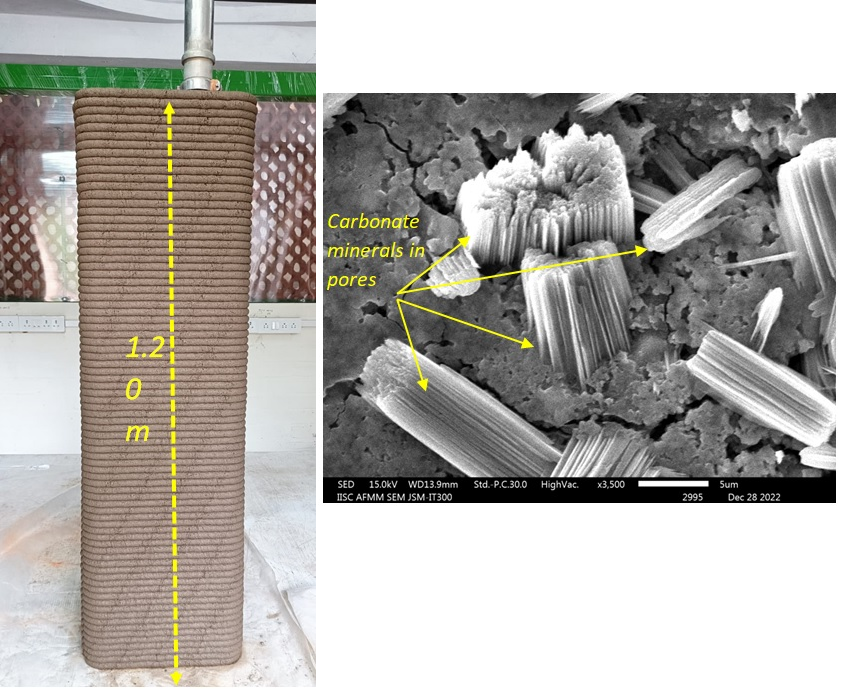Innovative low carbon construction materials developed using 3D printing technology can now be used for carbon sequestration and utilisation to reduce carbon emissions in the building industry are in line with the National "net-zero" targets by 2070.
India's cement and brick manufacturing sectors contribute a staggering 200 to 250 million tons of carbon dioxide (CO2) annually, a challenge that becomes ever more pressing as the country commits to achieving "net-zero" emissions. The mission to realize sustainable, low-carbon construction depends on two critical goals: reducing the reliance on mined resources and curbing the CO2 emissions inherent in material production, known as embodied carbon. At the forefront of this innovative endeavour lies the concept of "accelerated carbonation curing." This process leverages CO2-rich industrial flue gases to mineralize carbonates within construction materials, creating a stable and permanent means of CO2 storage.
In a significant step towards sustainable construction, researchers under a multilateral project (Acronym 3D Printing) from the Indian Institute of Science (IISc), Bengaluru, funded jointly by the Department of Science and Technology (DST) under the Trans-national platform of Accelerating CCUS Technologies, have pioneered breakthrough materials and processes that could bring down the building industry's carbon emissions. The Centre for Sustainable Technologies in IISc Bengaluru has utilized 3D printable material formulations utilizing industrial by-products, including construction and demolition wastes (CDW), blast furnace slag, and fly ash for carbon sequestration.
The 3D printable material formulations have been developed utilizing industrial by-products, including construction and demolition wastes (CDW), blast furnace slag, and fly ash. These formulations have the potential to be used in fabricating walls, slabs, and various other building components. The developed material, utilizing an optimized process of accelerated carbonation curing, can store 35 - 40% of CO2 by mass of cement. The exact percentage depends on factors such as density, curing conditions, and mixture formulation. An additional benefit is the formation of small crystals of carbonate minerals during the sequestration process, which enhances the engineering performance of the material.
The 3D printing team is driving the development of low-carbon construction materials capable of capturing substantial volumes of CO2 from industrial streams, aligning seamlessly with the DST-CCUS and Accelerating CCS Technologies programs. The IISc Bengaluru leads the bilateral Indo-US consortium including the Indian Institute of Technology, Roorkee, Sandia National Labs (USA), and Oregon State University (USA). The consortium is working to combine innovations in the design of building components via additive manufacturing (or 3D printing), and the development of new materials and pathways to maximize carbon sequestration, while improving strength and durability.
The research by the IISc team has been published in the Journal of Construction and Building Materials. This advancement on the 3D printed materials could serve as a sustainable substitute, capable of replacing up to 75% of natural sand in cement-based construction materials. Notably, this innovation offers a pathway to reduce the reliance on energy-intensive steam curing and minimize the extraction of mined resources, including natural aggregates and Portland cement. Beyond its role in transforming buildings into "carbon sinks," this technology also offers a solution to the challenges associated with managing construction and demolition waste (CDW) and other by-products. Currently, the consortium is actively engaging with industries to expedite the technology's scale-up process and explore direct CO2 sequestration opportunities from flue streams.

Formation of carbonate minerals in the pores and bulk matrix of the developed 3D printable material during carbon sequestration (IISc, Bangalore). The crystals are 3 – 5 micrometers in size and thus densify the material matrix.






























